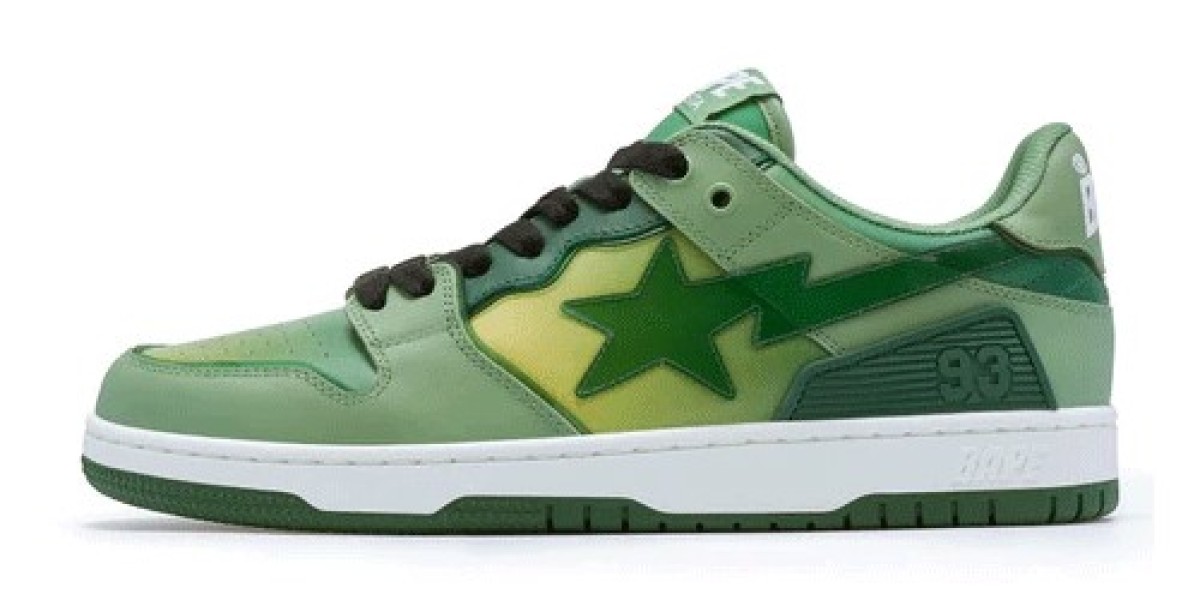In the world of sneaker culture, few shoes carry the weight of legacy and hype quite like the Bapesta. Born out of Japan’s vibrant streetwear movement, this sneaker has stood the test of time, earning its place alongside some of the most revered kicks in history. Whether you're a seasoned sneakerhead or just stepping into the culture, understanding the story of the Bapesta gives insight into the global fusion of fashion, music, and urban identity.
The Birth of Bapesta: A Symbol of Japanese Streetwear Rebellion
To understand the Bapesta, you must first know about A Bathing Ape (BAPE) — the pioneering Japanese streetwear brand founded by Nigo in 1993. Known for its bold camo patterns, ape motifs, and limited-edition drops, BAPE quickly became a cultural phenomenon in Tokyo's Harajuku district and eventually across the globe.
In 2002, Nigo introduced the Bapesta, a sneaker that bore an unmistakable resemblance to Nike’s Air Force 1. But it wasn’t just a copy — it was a remix. The Bapesta took the silhouette and infused it with everything BAPE stood for: bright colors, patent leather, star logos (instead of Nike's Swoosh), and loud personality. This reinterpretation turned heads and sparked debate, but ultimately cemented the Bapesta as a legitimate and innovative force in sneaker design.
Cultural Impact: From Tokyo Streets to Hip-Hop Royalty
The early 2000s saw a massive crossover between fashion and music, and the Bapesta was right in the middle of it. Hip-hop artists like Pharrell Williams, Kanye West, and Lil Wayne were frequently spotted in Bapestas, catapulting the sneaker from niche Japanese icon to a global streetwear staple.
When Kanye West collaborated with BAPE on a limited-edition Bapesta featuring his Dropout Bear logo, it became one of the most sought-after sneakers of the decade. Pharrell, meanwhile, formed a strong partnership with Nigo, co-founding the Billionaire Boys Club (BBC) — another fashion brand that further spread BAPE’s influence in Western pop culture.
The Bapesta became more than a shoe — it was a status symbol, a piece of wearable art, and a cultural bridge between East and West.
Design Elements: What Makes a Bapesta Unique?
The Bapesta’s design is bold and instantly recognizable. At first glance, it mirrors the Nike Air Force 1’s silhouette, but on closer inspection, several distinct features emerge.
Star Logo (STA): Replacing the Nike Swoosh is a lightning bolt-style star, which gives the shoe its signature branding.
Patent Leather: Bapestas are often made with glossy, high-shine patent leather in vibrant colorways that command attention.
Chunky Sole & Heel Logo: The sole design, while reminiscent of AF1s, is tweaked with subtle branding elements. The heel typically features the BAPE logo or “Bapesta” text.
Limited Drops: Like many hyped sneakers, Bapestas are often released in limited runs, making them highly collectible.
These design choices made the Bapesta a symbol of individuality and exclusivity — core tenets of streetwear identity.
Collaborations: The Fuel Behind the Hype
What sets BAPE apart — and by extension the Bapesta — is its knack for collaborations. From high-fashion designers to comic book brands and video game franchises, BAPE has partnered with a wide range of icons, always pushing the creative boundaries of sneaker culture.
Notable Bapesta collaborations include:
Kaws x Bapesta – Fusing art and footwear with the iconic “XX” motif.
Marvel x Bapesta – Featuring superheroes like Iron Man and Spider-Man in vibrant sneaker designs.
Coach x Bapesta – A luxury streetwear crossover with refined materials and co-branded details.
These collabs helped keep the Bapesta fresh and relevant, even as trends evolved and competitors entered the scene.
The Bapesta Comeback: A New Era for an Old Favorite
After a relatively quiet period in the mid-2010s, BAPE has re-energized its Bapesta line with fresh colorways, refined materials, and smart collaborations. Nigo's departure from BAPE didn’t slow the brand’s momentum — if anything, it created space for new creative directions.
Recent drops have leaned into nostalgia while also embracing modern streetwear aesthetics. Think monochromatic tones, camo-infused panels, and a renewed focus on premium construction. The reimagined Bapestas aren’t just throwbacks — they’re statements of evolution.
How to Style the Bapesta: Streetwear Staples with a Statement
The Bapesta is bold, and styling it requires balance. Because of its loud color schemes and eye-catching silhouette, it’s often best paired with understated outfits — but there are no hard rules in streetwear.
Many fashion-forward individuals style Bapestas with:
Baggy cargo pants or carpenter jeans
Oversized graphic tees or BAPE hoodies
Vintage windbreakers or varsity jackets
Minimalist accessories to avoid clashing
For those looking to dress up the sneaker, recent leather-clad Bapestas in neutral colors pair well with street-tailored fits — think cropped trousers and a bomber jacket. The key is letting the sneaker speak while maintaining a cohesive outfit.
Where to Buy Bapestas: A Collector’s Journey
Due to their exclusivity, authentic Bapestas can be tricky to find, especially older models or limited-edition collaborations. BAPE’s official website and flagship stores are the best places to start for new releases. For rare pairs, sneaker marketplaces and resale platforms like StockX, GOAT, or Grailed offer vetted listings, though prices can vary significantly.
Collectors should also stay informed through sneaker blogs, social media accounts, and Discord groups dedicated to streetwear and sneaker culture. The Bapesta release schedule can be unpredictable, making insider knowledge a valuable asset.
Bapesta vs. Air Force 1: The Eternal Debate
No discussion of Bapesta is complete without addressing the Air Force 1 comparison. While it's true that Bapesta was heavily inspired by the AF1, its cultural significance and design ethos have diverged over time. Where the AF1 is timeless and widely accessible, the Bapesta is more experimental and exclusive.
The debate often comes down to taste: the AF1 is a universal classic, while the Bapesta is for those looking to stand out. In many ways, both shoes complement each other, serving different roles within the sneaker ecosystem.
Final Thoughts: The Legacy and Future of Bapesta
More than two decades after its debut, the Bapesta remains a powerful symbol in fashion and sneaker culture. It's a reminder that reinterpretation can be just as impactful as innovation — that a shoe can be more than footwear; it can be a statement, a piece of art, and a cultural icon.
As new generations discover streetwear and its icons, the Bapesta is poised to continue its evolution. Whether you’re copping your first pair or digging through resale platforms for a grail, one thing is clear: the Bapesta isn’t just back — it never really left.








